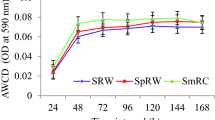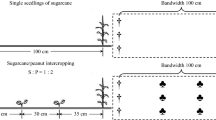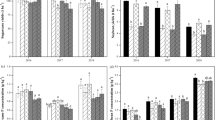Abstract
The effects of sugarcane plantation intercropped with soybean on plant growth, yield, enzyme activity, nitrogen and phosphorus contents, the microbe quantity of rhizosphere soil were investigated. Results showed that dry weight of biomass and yield under sugarcane/soybean intercropping were increased by 35.44 and 30.57 % for sugarcane, and decreased by 16.12 and 9.53 % (100-grain weight) for soybean, respectively. The nitrogenase activity of intercropping soybean nodule was significantly increased by 57.4 % as compared with that in monoculture models. The urease activities of intercrops sugarcane and soybean were promoted by 89 and 81 % as compared to that of the monoculture models, respectively. The effective nitrogen and phosphorus contents of rhizospheric soil of intercrops sugarcane and soybean were increased by 66 and 311.7 %, respectively, as compared to those in the monoculture system. Microbe number of rhizosphere soil in the intercropping pattern increased significantly as compared to those in the monoculture models. The quantities of bacteria, fungi, and actinomyces increased by 42.62, 14.5 and 78.5 % in the intercropping sugarcane, while the intercropping soybean increased by 188, 183 and 73 %, respectively. Therefore, growing sugarcanes in combination with soybean can be considered a good agriculture management practice, helping to promote plant growth, yield and increase soil nutrients.










Similar content being viewed by others
References
Aggarwal PK, Garrity DP, Liboon SP, Morris RA (1992) Resource use and plant interactions in a rice-mungbean intercrop. Agron J 84:71–78
Berg MP, Kniese JP, Verhoef HA (1998) Dynamics and stratification of bacteria and fungi in the organic layers of a Scots pine forest soil. Biol Fertil Soils 26:313–322
Bokhtiar SM, Majid MA, Islam MJ (1995) Fertilizer management for sugarcane-potato intercropping in the Old Himalayan Piedmont Plain soils of Bangladesh. Bangladesh J Sugarcane 17:107–112
Chai Q, Huang P, Huang GB (2005) Effect of intercropping on soil microbial and enzyme activity in the rhizosphere. Acta Pratacul Turae Sin 14(5):105–110
Chowdhury MK, Rosario EL (1994) Comparison of nitrogen, phosphorus and potassium utilization efficiency in maize/mungbean intercropping. J Agric Sci 122:193–199
Dick RP (1994) Soil enzyme activities as indicators of soil quality. In: Doran JW, Coleman DC, Bezdicek DF, Stewart BA (eds) Defining soil quality for a sustainable environment, SSSA Special Publication Number 35. Soil Science Society of America, Madison, pp 107–124
Evan AC (1960) Studies in intercropping. I. Maize or sorghum with groundnuts. East Afr Agric J 26:1–10
Gianfreda L, Bollag JM (1996) Influence of natural and anthropogenic factors on enzyme activity in soil. In: Stotzky G, Bollag JM (eds) Soil biochemistry, vol 9, pp 123–193
Guan SY (1986) Soil enzyme and its analysis method. Agriculture Press, Beijing
He JF, Huang GQ, Liao P, Liu XY, Su YH (2006) Effects on disaster reduction of maize/soybean intercropping ecological system on upland red soil. Meteorol Disaster Reduct Res 29(4):31–35
Huang RH (2002) The primary report of comparative experiments of wide-rows cultivation for sugarcane. Guangxi Sugarcane Canesugar 4:16–17
Imam SA, Hossain AHMD, Sikka LC, Midmore DJ (1990) Agronomic management of potato/sugarcane intercropping and its implication. Field Crop Res 25:111–122
Ledgard SF, Frency JR, Simpson JR (1985) Assessing nitrogen transfer from legumes to associated grasses soil. Boil Biochem 17:575–577
Li L, Li XL, Zhang FS, Yang SC, Lu MJ (2000) Uptake and utilization of nutrition as related to yield advantage in wheat/soybean intercropping. Plant Nutr Fertil Sci 6(2):140–146
Liu GS, Jiang NH, Zhang LD, Liu ZL (1996) Soil physical and chemical analysis and description of soil profiles. In: Sun HL, Liu GS (eds) Standard methods for observation and analysis in Chinese Ecosystem Research Network. Standards Press of China, Beijing, pp 5–40
Marschner P, Marino W, Lieberei R (2002) Seasonal effects on microorganisms in the rhizosphere of two tropical plants in a polyculture agroforestry system in Central Amazonia, Brazil. Biol Fertil Soils 35:68–71
Moscatelli MC, Fonck M, Angelis PD, Larbi H, Macuz A, Rambelli A, Grego S (2001) Mediterranean natural forest living at elevated carbon dioxide: soil biological properties and plant biomass growth. Soil Use Manag 17:195–202
Ofori F, Stern WR (1987) Cereal–legume intercropping systems. Adv Agron 41:41–90
Putnam DH, Herbert SJ, Vargas A (1986) Intercropped corn-soyabean density studies, II. Yield composition and protein. Exp Agric 22:373–381
Ruggiero PDJ, Bollag JM (1996) Soil as a catalytic system. In: Stotzky G, Bollag JM (eds) Soil biochemistry, vol 9, pp 79–122
Sasakawa H, Trung BC, Yoshida S (1986) Stem nodulation on Aeschynomene indica plants by isolated rhizobia. Soil Sci Plant Nutr 32:145–149
Sathyavely A, Chinnasamy K, Rujubekarum S (1991) Studies on intercropping in sugarcane with pulses and oilseeds. SISSTA Sugar J 17:35
Singh NB, Singh PP, Nair KPP (1986) Effect of legume intercropping on enrichment of soil nitrogen, bacterial activity and productivity of associated maize crops. Exp Agric 22:339–344
Tang JC, Mboreha IA, She L, Liao H, Chen HZ, Sun ZD, Yan XL (2005) Nutritional effects of soybean root architecture in a maize/soybean intercropping system. Sci Agric Sin 38(6):1196–1203
Yadav RL, Prasad SR, Singh K (1987) Fertilizer requirement and row arrangement of pulses in sugarcane based cropping systems. Indian J Agron 32:80–84
Acknowledgments
This work was supported by the National Natural Science Foundation of China (No. 31171508), Special Fund for Agro-scientific Research in the Public Interest (No. 200903002), and Modern Agro-industry Technology Research System (No. CARS-04-PS09).
Author information
Authors and Affiliations
Corresponding author
Additional information
Communicated by O. Ferrarese-Filho.
Rights and permissions
About this article
Cite this article
Li, X., Mu, Y., Cheng, Y. et al. Effects of intercropping sugarcane and soybean on growth, rhizosphere soil microbes, nitrogen and phosphorus availability. Acta Physiol Plant 35, 1113–1119 (2013). https://doi.org/10.1007/s11738-012-1148-y
Received:
Revised:
Accepted:
Published:
Issue Date:
DOI: https://doi.org/10.1007/s11738-012-1148-y




